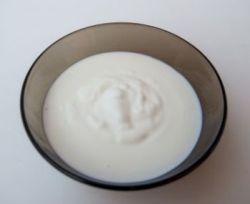Low temperatures and bad weather breed many infections, to which our body is very vulnerable during the autumn-winter period. Of course, the best cure is always … sport! I wrote about the amazing effects that sport has on health in this article.
Howerer, equally important to keep a proper diet. In order to maintain health and strengthen the immune system we should complement our diet with appropriate nutrients. Only then will we provide our body with adequate shots of energy and improve the immunity.
We do not have to be swallowing handfuls of pills to fill in the missing micro- and macronutrients. It’s enough to remember about eating breakfast everyday and, if possible, avoiding processed foods. Tasty, warming up breakfast will put our bodies at full speed and provide necessary energy and vitamins – A, B6, C and E, which protect us against infections. Our body also needs a stable and continuous supply of energy rather than fast, but short shots, so let’s choose whole grain products instead of white breads and monosaccharide.
Below is a list of foods that should be incorporated into our diet during this hard time.
YOGHURT AND KEFIR

Yoghurts and kefirs have cooling properties, so in winter we’d rather have a warming up, creamy oatmeal or hot milk with various additives, but let’s not give up yoghurt and kefir completely. Regular consumption of probiotics („good” bacteria) found in fermented dairy products such as yoghurt and kefir, are beneficial to the immune and digestive systems by preventing infections. Probiotic bacteria create in our digestive tract and intestines a kind of protective barrier that prevents the harmful micro-organisms contained in food from entering the body.
OAT AND BARLEY
 Unlike with yoghurt, winter is the ideal time to consume the cereals is in the form of oatmeal, which can be made of both oat and barley. Thse grains contain beta-glucan (which, in the digestive tract, assumes the consistency of a gel, lining the gastrointestinal mucosa and creating a kind of protective „dressing”. It slows down the absorption of sugars and strengthens the immune system – here is the recipe for oatmeal). According to the Norwegian study, antimicrobial and antioxidant properties of beta-glucan are stronger than those of echinacea. Eating oat and barley also speeds up the rate of wound healing.
Unlike with yoghurt, winter is the ideal time to consume the cereals is in the form of oatmeal, which can be made of both oat and barley. Thse grains contain beta-glucan (which, in the digestive tract, assumes the consistency of a gel, lining the gastrointestinal mucosa and creating a kind of protective „dressing”. It slows down the absorption of sugars and strengthens the immune system – here is the recipe for oatmeal). According to the Norwegian study, antimicrobial and antioxidant properties of beta-glucan are stronger than those of echinacea. Eating oat and barley also speeds up the rate of wound healing.
CITRUS FRUITS

Citrus fruits are commonly associated with high content of vitamin C. Oranges, grapefruits and lemons contain significant amounts of this vitamin that improves the immune system during cold and flu. Moreover, citrus fruits contain bioflavonoids, which seal the walls of blood vessels and, during infections, display anti-inflammatory properties and support vitamin C.
It’s very easy to introduce citrus fruits into our diet – lemon can be squeezed into tea (preferably cooled down a bit – vitamin C is destroyed in boiling water), while oranges and grapefruits can be used as refreshing juices or cut into to salads.
BALL PEPPER

We usually associate citrus fruits with high content of vitamin C. It turns out, however, that ball pepper, especially the red variety, has twice the amount of this precious vitamin. It’s also a rich source of beta-carotene, which helps keep the skin (which also suffers from contact with winter conditions) healthy.
Ball pepper is a fantastic, crunchy addition to salads or sandwiches. Let’s remember that each meal should contain a serving of a vegetable or fruit.
BROCCOLI

Broccoli is not only a „superfood” (a nutrient-rich food considered to be especially beneficial for health and well-being – Oxford Dictionary), but also a vegetable extremely strengthening our immunity. Charged with vitamins A, C, D and E (a natural antioxidant), broccoli stimulate the nervous and immune systems, as well as fight the Helicobacter pylori bacteria, responsible for the formation of stomach ulcers.
If you combine steamed broccoli with low-fat cottage cheese and pumpkin seeds or sunflower seeds, you receive a complete set of necessary to our body vitamins and trace elements.
NUTS

True that all kinds of nuts are high-calorie, but they are also extremely rich in healthy fats and vegetable protein, as well as vitamin E, which removes harmful free radicals and supports vitamin C. Even a handful of nuts satisfies 1/2 of the daily recommended dose of vitamin E. Riboflavin and Niacin (large quantities in almonds) help protect the body against the damaging effects of stress.
Nuts are a fantastic addition to yoghurt or oatmeal, so we can create a true vitamin bomb for arganism.
GREEN TEA

Teas, both green and black, are full of flavonoids, i.e. valuable antioxidants. Moreover, green tea contains large amounts of
Teas, both green and black, are full of flavonoids, which is valuable antioxidants. In this case, green tea contains large amounts of epigallocatechin gallate (EGCG) (a compound from the group of flavonoids, 100 times more potent than vitamin C and 25 times stronger than vitamin E ).
At Harvard University study revealed that people who drink five cups of tea per day for a period of 2 weeks, showed 10 times higher levels of interferon (a protein activating the immune system cells, increasing the rate of infection diagnosis and strengthening healthy cells’ immunity) in the blood.
The study at Harvard University shows that people who drink five cups of tea per day for a period of 2 weeks, showed 10 times higher levels of interferon (a protein activating cells of the immune system, increase the rate of diagnosis of infection and strengthening immunity healthy cells – Wikipedia) in the blood.
HONEY

Honey is delicious and probably there’s no need to persuade anyone to introduce it into their diet. It has powerful health benefits – mostly thanks to enzymes derived from the salivary glands of insects, apidicin and inhibin, i.e. natural antibiotics, acting against staphylococcus and streptococcus. Honey contains a hydrogen peroxide having strong bacteriostatic properties and large quantities of trace elements like potassium, magnesium, calcium, iron, chlorine, phosphorous and manganese, vitamins A, B1, B2, B6, B12, C, folic acid and biotin.
Linden honey shows antipyretic and expectorant properties and intensifies sweating, thus quickly removing toxins from the body.
SPROUTS
 Sprouts are associated mainly with eastern cuisine and we rarely use them in our kitchen. This is a mistake, as they are a real fountain of health. They contain vitamins and micronutrients: vit. A, B1, B2, B3, B5, B6, B9, C, E and potassium,magnesium, calcium, iron, phosphorus, selenium, manganese, iodine, copper, silicon, zinc and molobden. If this wasn’t enough, there are also a good source of fiber, regulating the digestive system. They contain everything our body needs, only several dozen more condensed and easily digestible. Furthermore, they are very low in calories.
Sprouts are associated mainly with eastern cuisine and we rarely use them in our kitchen. This is a mistake, as they are a real fountain of health. They contain vitamins and micronutrients: vit. A, B1, B2, B3, B5, B6, B9, C, E and potassium,magnesium, calcium, iron, phosphorus, selenium, manganese, iodine, copper, silicon, zinc and molobden. If this wasn’t enough, there are also a good source of fiber, regulating the digestive system. They contain everything our body needs, only several dozen more condensed and easily digestible. Furthermore, they are very low in calories.
The easiest way to use sprouts in kitchen is to decorate a sandwich or any pasta dish with them.
GARLIC

Garlic, for a change, can be found in the cuisines all over the world. For centuries, it has been known and used as a natural and very strong antibiotic. It contains allicin, which shows a strong antibacterial and antifungal properties and slows down the propagation of viruses. In addition, it reduces levels of bad cholesterol (LDL), regulates blood pressure and reduces the risk of blood clots and stroke.
Garlic is best eaten fresh, because the active ingredients it contains are destroyed within an hour of its peeling.
GINGER
 Ginger has a very clear, hot and slightly bitter taste and intense, sweet and slightly lemon flavor. It is considered the oldest medicinal plant. It shows strong warming properties and increases blood circulation. It is recommended for people with a tendency to cold hands or feet and pale complexion. It contains vitamins B1, B2, C and trace elements: calcium, phosphorus, iron and potassium. Ginger root is recommended for colds, vomiting, diarrhea, cough, food poisoning and indigestion. It also shows diaphoretic properties.
Ginger has a very clear, hot and slightly bitter taste and intense, sweet and slightly lemon flavor. It is considered the oldest medicinal plant. It shows strong warming properties and increases blood circulation. It is recommended for people with a tendency to cold hands or feet and pale complexion. It contains vitamins B1, B2, C and trace elements: calcium, phosphorus, iron and potassium. Ginger root is recommended for colds, vomiting, diarrhea, cough, food poisoning and indigestion. It also shows diaphoretic properties.
Fresh ginger combines perfectly with seafood, some meats and sweet foods. It is used as a refreshing spice. Suitable for soups and creams, e.g. a carrot or pumpkin cream.
CINNAMON
 Health benefits of cinnamon have been known for centuries. It was served as a medicine to improve blood circulation, with digestive problems or muscular and menstrual pain. It was used in oral hygiene as well.
Health benefits of cinnamon have been known for centuries. It was served as a medicine to improve blood circulation, with digestive problems or muscular and menstrual pain. It was used in oral hygiene as well.
Cinnamon protects against bacteria, fungi and viruses, and warms up very strongly. It affects greath the respiratory system – cleans the sinuses and helps with colds. Significantly increases the resistance of our body, relaxes and puts in a better mood.
Together with ginger they aromatize splendidly. You can add it to oatmeal, chocolate milk, pudding or other desserts.
TURMERIC

This bitter, intensely yellow spice is a key component of curry spice and Thai curry sauces. It has aromatic, slightly bitter taste and is mainly used as a powder. It has long been used as an anti-inflammatory agent and in the treatment of bones and joints. Promotes wound healing and reduces cholesterol. It shows anti-tumor effect and stimulates the immune system – turmeric is said to be eight times more potent than vitamin C.
Despite its use in spices and curry sauces, try adding turmeric to the water in which rice is cooked. It will give the rice an intense yellow color, and by the way we can use its valuable medicinal properties.
As shown above, opportunities to strengthen our immune system are very broad, and maintaining good health is not at all that complicated. Simply, introduce at least some of the products from the list to your menu to combat diseases and enjoy good health while everyone around you sneeze and cough.
Remember, however, that „movement can substitute any medicine, but all the medicines taken together can not replace movement” :-)
If You find this article interesting, please share it using the social media buttons under the article. If you don’t want to share it, maybe at least like it? :-)



